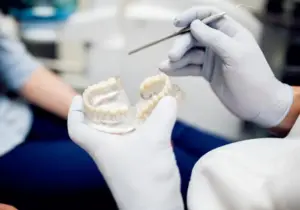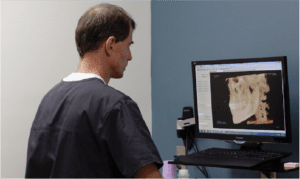
Gum disease starts as simple gingivitis and develops into periodontitis – where chronically-infected gums actually start to pull away from the bone, exposing tooth roots and causing decay and tooth loss. As gingivitis begins to progress, your gums will start to recede. And this isn’t just a health issue; it also affects the way your smile looks, and that can take just as much a toll on your mental health as it does your physical health.
There’s a simple solution: grafting the damaged gum tissue.
Soft Tissue Grafting for Smile & Gum Restoration
If you suffer from gum disease, soft-tissue grafting can help restore your gums to as good as new, which also protects the health of your teeth. It’s a way of reconstructing gum tissue that has eroded as a result of excessive gingival recession.
This is especially beneficial if your gums have worn away to expose tooth roots, which can make your teeth look long. Exposed roots can be especially sensitive to hot or cold foods or liquids, as well as other pain. Your teeth roots were never meant to see the light of day – if you start to see the darker parts of your teeth peeking through your gums, you need to get to the dentist right away.
To be honest, gum surgery sounds a lot worse than it actually is. We’ll numb the area so you don’t feel a thing. Local anesthetic is all that’s needed, but we can even give you a sedative during the grafting surgery to help you relax if you’re nervous. The process is really more like a regular dental care appointment than actual surgery.
Soft tissue grafting involves taking a piece of gum from somewhere else in your mouth and attaching it to the area of gum recession, supplementing the lost tissue. The oral surgeon sculpts a new, restored gum line, and that’s it: 2 steps, 1 quick procedure. You’ll be done in no time, and this little grafting surgery will have big and lasting effects on the appearance and health of your mouth.
Types of Soft Tissue Grafting for Periodontal Reconstruction
There are 4 types of soft tissue grafting; each is meant to correct a certain level of damage with the least-invasive methods possible:
Connective Tissue Grafts
This soft tissue supplementation is the most common treatment for exposed tooth roots. We cut a flap of skin at the roof of your mouth — an area known as subepithelial connective tissue. We then stitch this skin to the gum tissue of the exposed tooth so it’s restored to a healthy level of tooth coverage. Our oral surgeon carefully shapes the newly-placed graft to match the natural contours of healthy gums.
Free Gingival Grafts
Similar to connective tissue grafts, free gingival grafts remove tissue directly from the roof of the mouth that is then attached to the treatment area on the gum line. This method is used if you have thinning gums to begin with and need extra padding for protection.
Pedicle Grafts
This type of soft tissue graft uses skin from around the gum line and the tooth that needs repaired, rather than the area around the roof of the mouth. We partially cut the gum tissue, known as the pedicle, so that one edge remains attached. We then pull the gum down around the exposed tooth. This approach is ideal for people who have enough gum tissue to work with at the site, and prevents having to create the graft by harvesting soft tissue from elsewhere in the mouth.
Alternative Grafts
This type of gum graft is saved for cases of extreme recession that require an amount of tissue that is too much/dangerous to take from the roof of the mouth. For instance, if your periodontitis is so severe that several teeth in a row are severely exposed, the soft tissue graft will likely be harvested from a cadaver or biocompatible animal, like a pig.
At this stage of periodontitis, your whole-body health is also likely compromised, and this method of soft tissue grafting is more invasive and comes with more risks since the graft tissue isn’t yours. These grafts take longer to heal and have the possibility of being rejected, causing further complications. If you have reddened, swollen, or easy-to-bleed gums, get to your dentist right away. Don’t wait until your gingivitis has progressed to this extreme.
After Your Soft Tissue Graft: Care & Recovery
While you may return home immediately after the procedure, you’ll have to take special care of the area where the tissue was grafted from, as well as your new gum line. Dr. Puckett will give you detailed instructions on how to best care for healing. This includes a special diet and limiting certain physical activity.
You can treat any pain with over-the-counter medications. We believe in the efficacy of natural healing options, including homeopathic dental remedies like gentle saltwater rinses. As well, Dr. Puckett will offer our VEGA Recovery Kit at your pre-surgery appointment. This is a natural, 3-part pain management and recovery kit specifically made for oral surgeries. It’s a 7-day program that begins before your surgery, keeping you ahead of the pain and setting you up for speedy, effective healing. It’s the latest in holistic pain control for dental procedures.
The amount of pain you’ll feel depends on the area the tissue was grafted from, as well as the amount of tissue removed. You will essentially have a wound in your mouth that feels like you burned it from hot pizza or soup. It tends to heal quickly.
A few tips for your first week, to optimize healing from your gum graft surgery:
- Stick to soft foods that aren’t cold or hot
- Avoid crunchy or hard-to-chew foods
- Do not brush the grafted area
- Do not floss the grafted area
- Gently swish with antimicrobial mouthwashes
Don’t forget to go to your post-op follow-up with our oral surgeon to monitor your healing and the success of the soft tissue graft. Take any prescribed antibiotics. And keep up with the recovery kit; you’ll be glad you did.
Don’t Complicate Recovery: Avoid these Unhealthy Pitfalls
One thing that can easily cause a soft tissue graft to fail is smoking tobacco; so if you smoke, please be advised that you can have a difficult time healing from soft tissue grafting. This is because smoking constricts the blood vessels, making it harder for your mouth to heal from soft tissue grafting, dental implant surgery, and other oral surgeries. Not to mention all the nasty chemicals you’re suffocating the gum tissue with.
Smoking can cause a gum graft to fail, and can even cause tissue necrosis in your remaining gums. If you smoke, we strongly urge you to quit to help the healing process following your oral surgery. Other habits that should be avoided and health conditions that should be managed to maximize the healing process include:
- Unhealthy diet
- Excessive alcohol use
- Neglecting dental care
- Diabetes
- Obesity
- Immunodeficiencies
Don’t worry – our oral surgeon, Dr. Puckett, will go through all of these things with you in detail. For most patients, a soft tissue graft is nothing, and it hugely improves their self-confidence while preserving their oral health. If you have receding gums and are considering supplementing them with a graft surgery, contact our office with questions and schedule an initial appointment.








